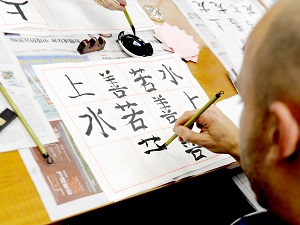The 8 Rules of Chinese Character Stroke Order

Even in today’s electronic age, it is still important to learn proper stroke order for handwriting Chinese characters. First and most importantly, writing Chinese characters by hand is absolutely essential if you want to memorize them well. While you will often use a computer to type, this pinyin input method only requires you to be able to recognize the Chinese character; you don’t create the character from memory when typing on a computer. To learn Chinese characters for long-term retention, it is necessary to write them by hand and if you are going to write by hand then you should learn to write correctly.
Using the proper stroke order will create attractive, well-balanced Chinese characters. Additionally, if you are looking up a character in your smartphone's Chinese dictionary, handwriting input is much faster and easier than searching by radical. However, you should use the proper stroke order so that the dictionary will recognize your handwriting. Using the wrong stroke order will usually confuse the dictionary and it will not show the proper Chinese character, even though the character you drew looks very similar.
That being said, stroke order is very predictable in Chinese, so you don’t need to know the pronunciation, meaning or even the radical to know the proper stroke order. Just remember the following rules and practice, practice, practice!
- Characters should generally be written from top to bottom, left to right. Horizontal strokes go from left to right. If you have two horizontal strokes, then the top one comes first. This can be seen in characters like 二 or 首. If the character has two or three components, like 谢, then start with the component furthest to the left, then the middle one, then the right one.
- When horizontal and vertical strokes intersect, the horizontal stroke (or strokes) comes first. The vertical stroke (or strokes) is often the finishing stroke. Examples: 件,十,事 ,弗 (Technically, the vertical stroke in 事 is a hook stroke, but the same principle applies.)
- Enclosures are written before the contents, starting with the left vertical, then the top and right in a single stroke. If there is a bottom horizontal stroke on the enclosure, it is written after the contents. Examples: 间,回,日,月
- Bottom enclosures come last. Examples: 远,脑
- Right-to-left diagonals come before left-to-right diagonals. Examples: 人,父,六 . Also note that the top stroke in characters like 看 and 千 is a right-to-left diagonal. And the lower-left stroke in 没 and 冷 is written from the lower left corner towards the center.
- In vertically symmetrical characters, the center comes before the outside. Examples: 小,永,承
- Upper-left and upper-center dots come first. Examples: 六,文,请,间,弟
- Upper-right and inside dots come last. Examples: 玉,书,求
Want to learn how to write and read Chinese characters? Check out our 1-on-1, intensive group or part-time group reading and writing courses!
